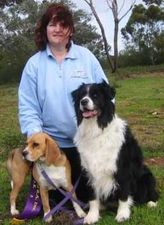The term positive training has become a buzz word in today's dog training community but there is some confusion about what it actually entails.
One of the most common misconceptions about positive training is that all we do is feed the dog, regardless of what the dog is doing, or that we allow the dog to get away with bad behaviour. Nothing could be further from the truth. Positive training manipulates consequences so that the dog will do what we want.
All behaviour is driven by consequences - either the dog does something because it is reinforced (i.e. it pays off in some way, is rewarded), or the dog does something to avoid punishment, or something unpleasant. Learning by consequences is a method of learning common to all species and the scientific term for this is operant conditioning.
One area of operant conditioning is called positive reinforcement. This simply means that a consequence is applied after the performance of a behaviour that makes that behaviour more likely to occur again in the future. Positive trainers take advantage of this principle when training dogs. We set the dog up so that it cannot make a mistake and then we reinforce what the dog does correctly by applying a consequence that the dog likes. Naturally the dog will want to repeat this behaviour since it gets reinforced and while he is busy doing good things he is not doing bad things.
By careful management we avoid placing a dog in a situation where he can fail. This avoids the need to use punishment (which is frequently unnecessarily used in dog training) and it can hardly be considered allowing the dog to run amok.
Another method of learning common to all species is called respondent conditioning, also known as classical conditioning or Pavlovian conditioning. This is learning by association. If something is pleasant, fun and exciting, the dog will want to do it again. If an activity is boring, or scary, or associated with pain, the dog will want to avoid it. Positive trainers make training enjoyable for dogs so that they are willing partners in the training process.
Positive training, or positive reinforcement training, is considered by many to be the new kid on the block. However this simply isn't true. Positive trainers employ methods based on findings that have been described in scientific literature since the late 1800s, by scientists, psychologists and animal trainers, such as Edward Lee Thorndike, J.B. Watson, Ivan Pavlov, B.F. Skinner, Keller Breland, Marion-Breland Bailey, Bob Bailey, Karen Pryor and many others.
Positive training methods have been used for decades to successfully train dozens of species of animals and will successfully train all breeds of dogs. Correctly applied positive training methods have a very high success rate even with those breeds perceived to be more difficult to train.
Positive training methods are gentle, humane and effective. They:
- Will help your dog to remain calm and stress free.
- Will help you train your dog in a pain and injury free manner.
- Will help to build the bond between you and your dog.
- Will help your dog to cope with situations that may otherwise cause aggression.
- Encourage you to remain calm and relaxed with your dog and provide training methods that young children can use under supervision from an adult.
Correctly used positive training methods:
- Will result in a dog who will do a fair day's work for a fair day's pay. A reward for work well done rather than punishment for failure to comply.
- Will set the dog up for success, minimising errors and eliminating the use of punishment-based training.
- Will provide the desired and reliable responses you want.
- Will eliminate confusion in the dog.
- Will increase the dog's confidence.
- Will provide clear guidelines of acceptable behaviour to the dog.
- Will create a dog that loves to obey because training is fun.
- Will give a dog the self-control required to be happy and carefree yet under guardian control. Positive does not mean permissive.
- Do minimise the chance of future behaviour problems occurring because it anticipates future behaviour based on normal dog behaviour.
- Can help successfully rehabilitate many fearful, anxious, shy or aggressive dogs.
- Result in happy dogs and happy guardians.
Positive training methods have been used to successfully train dogs for a wide range of tasks, including:
- Police Dogs
- Military Dogs
- Search and Rescue Dogs
- Scent detection dogs used by quarantine and customs services
- Guide dogs for people with sight impairment
- Service dogs for people with disabilities (including Endel, Dog of the Millenium)
- Bomb detection dogs
Positive training methods are preferred by reputable veterinary behaviourists, behaviour analysts and behavioural trainers worldwide, including but not limited to:
- Dr Ian Dunbar
- Dr Patricia McConnell
- Dr Kersti Seksel
- Dr Gaille Perry
- Jean Donaldson
- Prof Nicholas Dodman
- Karen Pryor
- James O'Heare
- Pamela Dennison
- Pat Miller
- Dr Pamela Reid
- Donna Duford
- Dr Murray Sidman
- Kellie Snider
*****

This article by Leandra Ford first appeared in 2007 on the website of Canine Behavioural School in Adelaide, S.A. and, in order to de-mystify what positive reinforcement training is and what it is not, it is reproduced here with the author's kind permission.
For another take on 'positive reinforcement training' see the FAQs section, 'What exactly is Positive Reinforcement training?'


